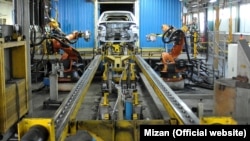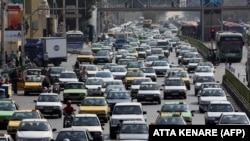Firing back at the governor of the Central Bank of Iran (CBI) for his recent caustic comments, the Auto Manufacturers Association (AMA) has accused him of extreme "demagoguery" and "lack of expertise."
The chairman of the AMA, Ahmad Nemat, warned on Monday, October 21, that if the auto manufacturing industry in Iran fails, the country will be forced to import 12-15 billion dollars of vehicles every year.
Earlier on Sunday, in an unprecedented attack, the CBI governor Abdolnasser Hemmati, had lashed out at local automakers for wasting their liquidity, demanding, "How long are you going to continue the inefficient production of vehicles?"
Responding to critics who had censured the CBI for being reluctant to bankroll the local auto industry, Hemmati noted that he had already allocated more than $1.2 billion (in the Iranian national currency, rial) for the automakers and 844 million euros (approximately $940 million) for auto parts manufacturers.
However, Hemmati in bitter criticism insisted that Iran’s semi-governmental automakers have squandered their liquidity and keep asking for more.
Retaliating to Hemmati's vitriolic remarks, and advisor to the AMA, Davoud Mirkhani, dismissed the CBI's claim, demanding, "Why did he say the auto industry is inefficient? Isn't the CBI crippled? CBI has failed to rein in the rate of inflation, liquidity, and defend the value of Iranian rial. The CBI is responsible for pushing the auto industry into the current situation."
Furthermore, Mirkhani insisted that if the country’s auto manufacturing was indeed crippled, the only way to save it was ending the CBI's inefficiency.
As in many other government-controlled sectors of the economy, the auto manufacturing industry is mired with corruption and mismanagement, although it is the biggest auto industry in the Middle east.
Iran's car manufacturing industry is suffering from "widespread financial corruption," a pro-reform member of Majles (parliament), Bahram Parsaei disclosed on August 17.
In August the CEO of Iran Khodro, one of the two largest automakers, was arrested on charges of corruption. Several managers from Saipa, another automaker are also in jail.
Iran Khodro is a partner with the French conglomerate PSA Peugeot Citroen.
"Widespread financial corruption has turned automakers in Iran into a powerful Mafia," Parsaei reiterated.
According to the lawmaker, two giant automakers in Iran owe $9 billion to the banks and $7.5 billion to parts manufacturers.
Furthermore, the automakers have accumulated up to $9 billion in losses, while they sold $7.5 billion of cars, according to figures Parsaei presented.
Iranian car manufacturers are mostly directly or indirectly government owned, and their losses impact other government institutions or government-owned banks, in a chain reaction.
Five years ago, Iran’s parliament had issued a report saying that these car companies were run with heavy-handed government control and political interference. The report had assailed lack of financial discipline and transparency.
Reports on widespread financial corruption in Iran have been rife in recent months.
Meanwhile, U.S. sanctions have also heavily impacted the car industry. European automakers that supply most parts to Iranian factories have stopped doing business with Iran.
Nevertheless, whenever criticized, the automakers resort to old stories, threatening to close factories and lay off many employees.
Iran initially developed a significant auto manufacturing industry with an annual production of up to 200,000 units under the country's pro-West monarch, Shah Mohammad Reza Pahlavi.
Nonetheless, after the 1979 Iranian Revolution, auto production drastically decreased due to Iran–Iraq War and international sanctions.
Currently, Iran's auto manufacturing is the country’s second biggest industry, after its oil and gas industry, accounting for 10% of Iran's GDP and 4% of the workforce (700,000 people), local news outlets say.
As a state-affiliated sector, the loss-making auto manufacturing business has always been widely criticized for being mired with corruption, mismanagement, and inherent incompetence.







